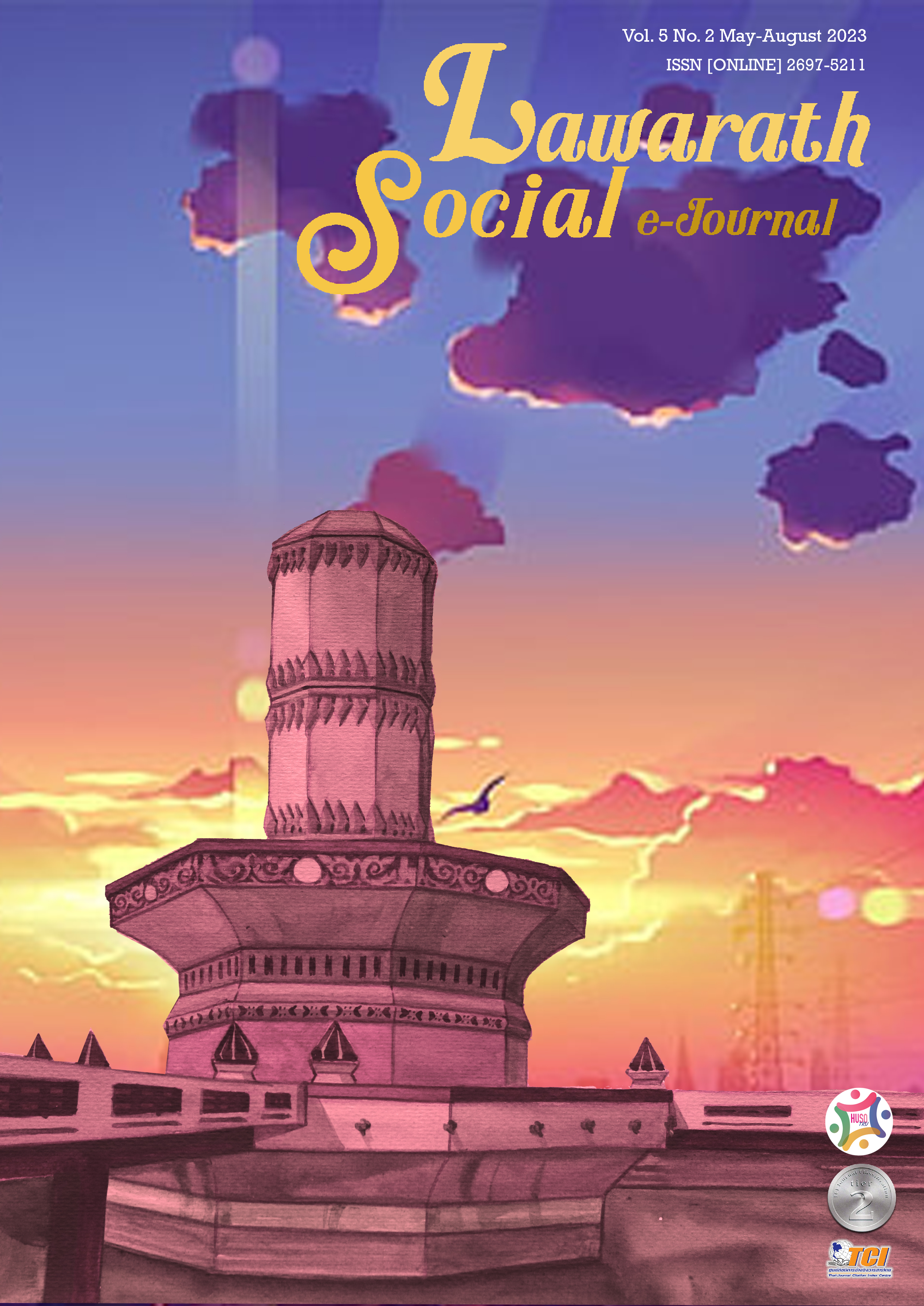Learning, Developing and Inheriting Process of Mudmee Weaving Wisdom for Creative Tourism Promotion Based-On Cultural Capital by Community-Based Tourism Management of Tai-Puan Hinpak Sub-District, Banmee District, Lopburi Province
Keywords:
Learning and Transmission Process, Mudmee Weaving Wisdom, Cultural CapitalAbstract
This research aims to study the processes of learning, developing, and inheriting the Mudmee weaving wisdom. It is regarded as an important cultural capital that is a base to support a creative tourism promotion following a community-based tourism management of the Thai-Puan community, Hinpuk sub-district, Banmee district, Lopburi province. This qualitative research collected data from thirty-four key informants who were selected using a purposive sampling and a snowball sampling. They were divided into two groups: fifteen village sage, village wisemen, and local leaders, and nineteen Tai-Puan, Mudmee weaving wisemen. The data were collected by doing a field study (community survey, in-depth interview, non-participant observation, focus group discussion, and documentary research. Data and methodological triangulation were employed to validate data, and Typological Content Analysis was used for data analysis. The main findings were: 1. in terms of community contexts, the economy condition and the Thai-Puan cultural capitals influenced Thai-Puan Mudmee weaving wisdom; 2. for the learning process of the weaving wisdom, it was passed down through household and communities system that the ex-generations taught their descendants to learn how to do patterns, tying, coloring, and weaving; 3. for the development of the weaving wisdom, it was instructed and transferred orally. People exchanged their knowledge and experiences, tried new techniques, or learned some techniques from government offices. Mudmee weaving was supported and developed by public businesses, government sections, customers, and Tai-Puan wiseman. All of these supports lead to the local wisdom reservation and transmission and high-standard Mudmee clothes. The development also supports local people to have stable jobs and incomes as the Mudmee weaving group is strong and independent. The group is a renounced weaving group in the province and also gains many awards and 4. the inheriting process of the weaving wisdom of Thai-Puan community, was done through families, community, and workshops. The inheritances were the descendants of the weaving group, members of the weaving group, people in the community, and those who were interested in weaving. The contents that they learned included patterning, tying, coloring, weaving, and goods value-adding techniques.
Downloads
References
กรมส่งเสริมวัฒนธรรม. (2566). แผนปฏิบัติราชการระยะ 5 ปี (พ.ศ. 2566 - 2570) ของกรมส่งเสริมวัฒนธรรม. กรุงเทพฯ: ผู้แต่ง.
เกียรติสุดา ศรีสุข. (2556). ระเบียบวิธีวิจัย (พิมพ์ครั้งที่ 3). เชียงใหม่: มหาวิทยาลัยเชียงใหม่.
จินต์ประวีร์ เจริญฉิม, และสิริชัย ดีเลิศ. (2563, พฤษภาคม-สิงหาคม). กระบวนการถ่ายทอดภูมิปัญญาผู้สูงอายุสู่ชุมชนและสังคมที่ยั่งยืน. วารสารปาริชาต มหาวิทยาลัยทักษิณ. 33(2), 152-167.
ชนัญ วงษ์วิภาค. (2545). การจัดการทรัพยากรการท่องเที่ยวเชิงวัฒนธรรม. เอกสารการสอนชุดวิชาประสบการณ์วิชาชีพการจัดการการท่องเที่ยว. นนทบุรี: มหาวิทยาลัยสุโขทัยธรรมาธิราช.
นิตติยา ทองเสนอ, และอุทิศ สังขรัตน์. (2558, เมษายน–กันยายน). การจัดการวัฒนธรรมและภูมิปัญญาท้องถิ่นเพื่อการท่องเที่ยวเชิงสร้างสรรค์ในตำบลเกาะหมาก อำเภอปากพะยูน จังหวัดพัทลุง. วารสารมนุษยศาสตร์สังคมศาสตร์ มหาวิทยาลัยทักษิณ, 10(1), 187-206.
พจนา สวนศรี. (2546). คู่มือการจัดการท่องเที่ยวโดยชุมชน. กรุงเทพฯ: โครงการท่องเที่ยวเพื่อชีวิตและธรรมชาติ.
พนิตสุภา ธรรมประมวล, และกาสัก เต๊ะขันหมาก. (2553). กลยุทธ์และแผนการตลาดเพื่อส่งเสริมการท่องเที่ยวเชิงวัฒนธรรมแบบมีส่วนร่วมในจังหวัดลพบุรี. กรุงเทพฯ: สำนักงานคณะกรรมการวัฒนธรรมแห่งชาติ.
รัตนะ บัวสนธิ์. (2558). การวิจัยเชิงคุณภาพทางการศึกษา (พิมพ์ครั้งที่ 5). กรุงเทพฯ: จุฬาลงกรณ์มหาวิทยาลัย.
นรินทร์ สังข์รักษา. (2555, มิถุนายน–ตุลาคม). แนวทางการส่งเสริมการท่องเที่ยวเชิงวัฒนธรรมในอู่อารยธรรม จังหวัดราชบุรี. วารสารศึกษาศาสตร์ มหาวิทยาลัยศิลปากร, 10(1), 148-161.
ศุลชัย สระทองหัก. (2565, กันยายน). กระบวนการเรียนรู้ของชุมชนเพื่อพัฒนาองค์ความรู้ชุมชน: กรณีศึกษาชุมชนชาติพันธุ์ไทยทรงดำ บ้านดอนทราย ตำบลสระกะเทียม อำเภอเมืองนครปฐม จังหวัดนครปฐม. Journal of Roi Kaensarn Academi. 7(9), 75-95.
สุดแดน วิสุทธิลักษณ์, และคนอื่นๆ. (2555). การท่องเที่ยวเชิงสร้างสรรค์. กรุงเทพฯ: องค์การบริหารการพัฒนาพื้นที่พิเศษเพื่อการท่องเที่ยวอย่างยั่งยืน (องค์กรมหาชน).
สุภางค์ จันทวานิช. (2553). วิจัยเชิงคุณภาพ (พิมพ์ครั้งที่ 18). กรุงเทพฯ: จุฬาลงกรณ์มหาวิทยาลัย.
องค์การบริหารส่วนตำบลหินปัก. (2565). ประวัติ/สภาพทั่วไป. สืบค้น กรกฎาคม 1, 2565, จาก https://www.hinpak.go.th/tambon/general.
Bourdieu, P. (1986). The Forms of Capital. In: Richardson, J., Handbook of Theory and Research for the Sociology of Education. Westport, CT: Greenwood: 58-241.
ICOMOS Australia. (1999). The Burra Charter: The Australia ICOMOS Charter for Places of Cultural Significance. Australia: Author.
Raymond, C. (2007). Creative Tourism New Zealand: The Practical Challenges of Developing Creative Tourism. In Richards G. and Wilson, J. (eds) Tourism, Creativity and Development. London: Routledge, pp. 145-157.
UNESCO. (2006). Towards sustainable strategies for creative tourism discussion report of the planning meeting for 2008. in International Conference on Creative Tourism. Santa Fe, New Mexico, USA. October 25-27, 2006.
Downloads
Published
How to Cite
Issue
Section
License

This work is licensed under a Creative Commons Attribution-NonCommercial-NoDerivatives 4.0 International License.



